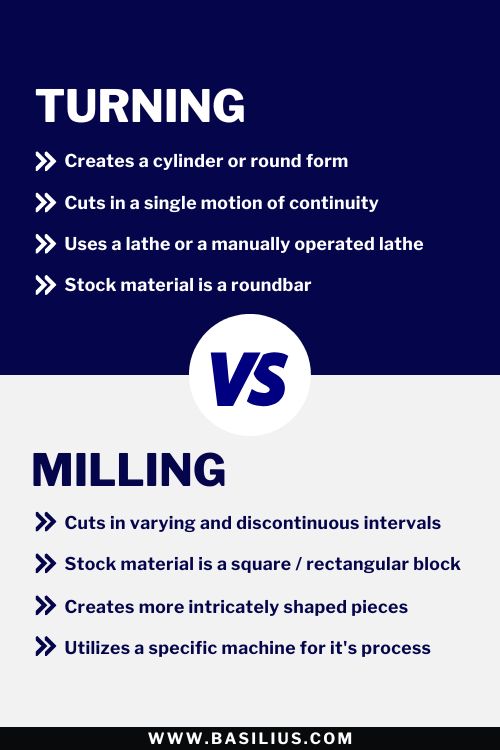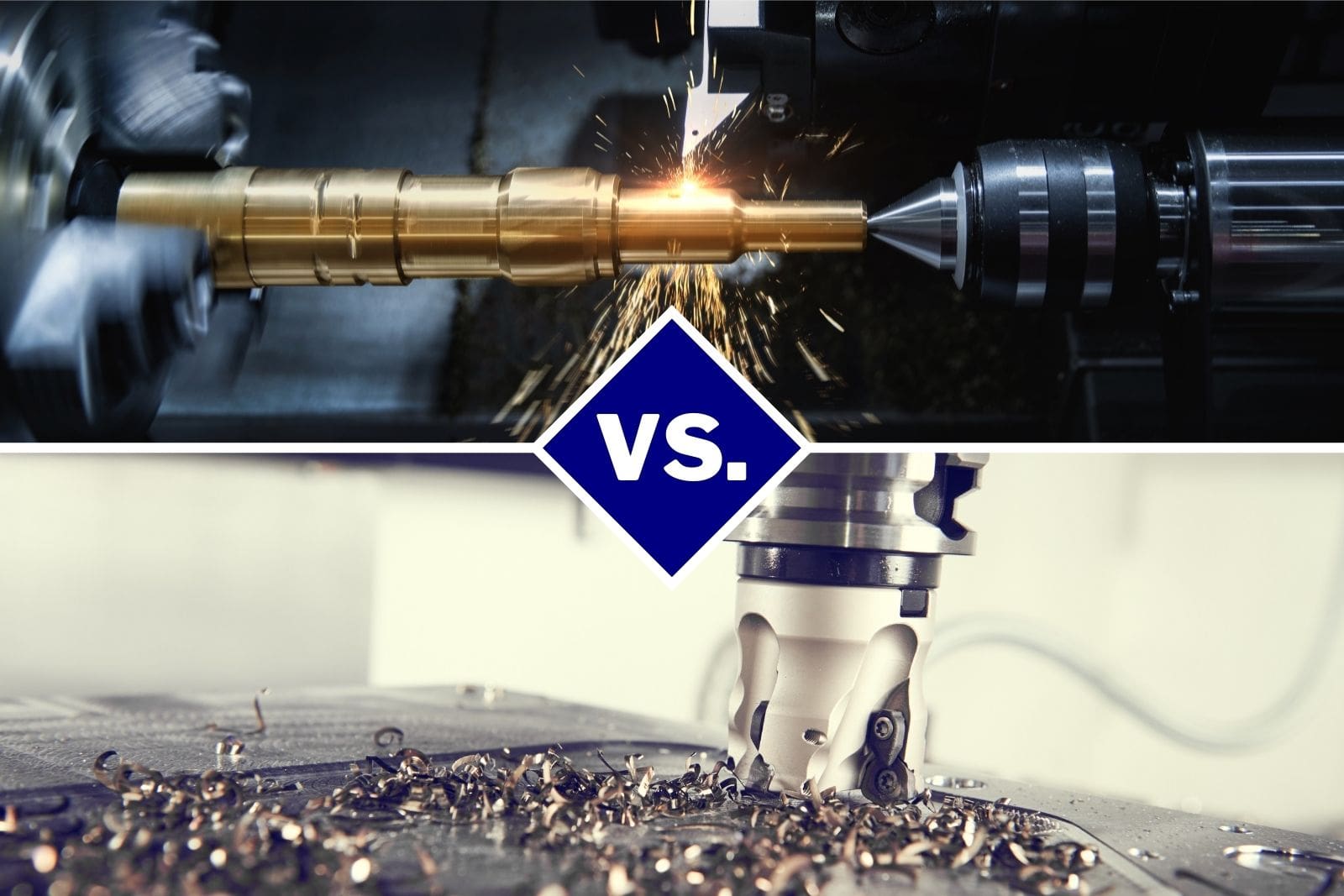What is stock?
Let’s start with a few of the basics. Stock, also known as blanks or billet, is the piece of material that you are shaping and/or processing through your machine. Stock comes in a variety of materials, shapes, and sizes. Your specific stock selection is based on your part design and desired end result.
Oftentimes, in CNC machining, the material being used is metal, but it can also be plastic or wood. Ultimately, your stock will become the part or a number of parts that you are creating. When utilizing the turning process you will often use stock referred to as roundstock, barstock, or rounds. Conversely, the milling process often uses steel or aluminum blocks, like 6061 aluminum or P20.
Now that we have the definition of stock out of the way, let’s look at the basics of both production methods.
Let Basilius help with every aspect of your CNC project. Request a quote today to get started.
The Process of Turning Stock
Turning stock is a popular machining process that is typically performed with a type of lathe. It is a subtractive process, meaning tools are used to remove material from your stock, ultimately forming your part. Once clamped into the chuck, the stock material rotates and the cutting tool is strategically directed into the workpiece. In the case of a manual lathe, the machine and tools are operated by a skilled technician throughout production. Whereas with a CNC machine, the production can be automated.
The Process of Milling Stock
Milling refers to a subtractive machining process where various rotary cutting tools are used to remove material from your stock. Often times your stock begins as a block of material versus the various round stock we typically see in turning. To create your desired part, various cutting tools, also known as milling cutters, are used one after the other to carve the material. Each tool interacts with the material in a unique way, and combining their capabilities ultimately leads to a very accurate end product.
Turning and Milling Similarities
You might have realized by now that there are many similarities between turning and milling stock. In order for you to make the most informed decision, we’ve covered them in great detail.
Material Used – Either process allows for the use of various metals including aluminum, steel, brass, copper, titanium, and more. Additionally, other materials such as plastics, wood, and even graphite can be utilized.
Subtractive Process – As noted previously, both processes are considered controlled and are centered around subtractive manufacturing.
Automation – Computer-aided design software (CAD) software can be utilized to automate either process. Giving you the capability to produce consistent quality parts with extreme precision.
It Generates Heat –Last but certainly not least, each process also generates a lot of heat. Meaning you’ll typically need to keep your workpiece cool with some form of coolant or cutting fluid. This is critical in preserving the life of your cutting tools and achieving a quality end result.
Critical Differences
We know turning and milling stock have a lot in common, however, if you want to choose the process that is best for you, consider their differences. It is there that you will find the most relevant information and limiting factors ultimately pushing you toward one versus the other.
Size Matters – Depending on the size of your final part, you find it impossible to produce with the turning process. Mills often have much greater size capacity and therefore you’d have better luck with the milling process.
Is It Round? – If you’re looking to machine a round part, then by now you know this is best done by turning on a lathe. All other shapes are best left to the milling process.
Your Desired Result – Commonly milling allows for the manufacturing of a much more complex part. Albeit a slower process. You can bridge the complexity gap a bit with a turret or automatic lathe.
Cost Benefit – Cost is a major factor in most production settings. It’s critical that you choose the right machining process for your part. For example, round parts are often best produced with a lathe. Additionally, lathes can often remove a high volume of material faster, leading to less machine time overall. Ultimately, designing your part for CNC machining will produce a cost-effective result.
Machine Choice – The machines that perform each process are vastly different and offer a wide range of varying capabilities. We dive deeper into the critical aspects of these machines next.

The Mechanics Behind The Machinery
The typical machines utilized for turning and milling stock are lathes and mills respectively. These machines vary greatly and offer a variety of pros and cons that should be considered when selecting your manufacturing process. We handpicked and discussed some of the most important aspects below.
LATHES
Lathes offer various tooling options, spindle options, and diameter limitations, all dependent upon the material you are working with and the capabilities of your machine. If you’re looking to produce a round or threaded part, there is no better machine to use. Even better automated lathes and turret lathes bring in far more functionality then their manual counterparts.
Manual Vs. Multi-Axis Lathes
With a manual lathe, a technician is required to operate various handwheels and levers to ensure a smooth and accurate production process. If you are new to the world of production, or unfamiliar with lathes you may find the manual versions have a bit of a learning curve. If you find yourself restricted to a manual lathe, we suggest keeping your parts as simple as you can, at least until you get used to the machine’s capabilities. Simplifying your parts has additional benefits too, like reducing cost.
If you are lucky enough to have access to a multi-axis lathe on the other hand, then the sky’s the limit. Well, almost. You still won’t be able to machine parts as large as you would with a mill. However, the computer-assisted element, the potential for multiple spindles, and often various tools will provide you with extended capabilities allowing you to make more complex parts.
Spindles
Spindles are another component that varies between each machine. The size, shape, and even number of spindles can vary greatly from machine to machine. When a machine has one spindle, all work is typically done on one side. While machines with two spindles, a main and sub spindle, can partially machine your part on the main spindle then have additional work done on the sub spindle. Ultimately, giving you the ability to reduce your machining time.
Live Tooling
When discussing lathes, live tooling is easily one of the most productive features you can have. Live tooling allows your machine to perform other tasks such as drilling holes, carving slots, tapping, and even small milled configurations all while your part maintains its indexed position. This drastically increases your capabilities and saves you time allowing for more complex yet still cost-effective parts.
Making Your Final Decision
We’ve discussed the vast complexities involved in deciding between turning and milling your stock. From similarities and differences to the machines you will use, there is a lot to consider. If you need a bit more intricacy or detail, look toward machining your part. However, if your part is round and more simple in nature, turning is likely a great fit. Don’t forget to consider your stock material and the size and shape of your part as well. All of these things should shape your decision. However, there is one important element that stands above the rest, your part itself. A solid consideration of its design will point you in the right direction.
Still not sure which production method is best for your part? We pride ourselves in guiding our customers from prototype to production. Simply contact us, or request a quote, and a member of our team will be happy to assist you!


